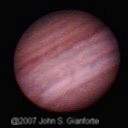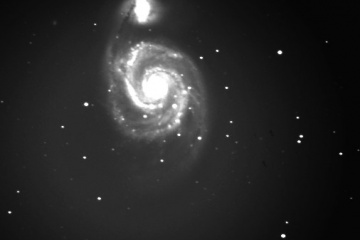An Astronomical Journey Back in Time
by John S. Gianforte, Blue Sky Observatory
In November of 2006, I attended a lecture by noted author, Dava Sobel, at the Christa Mc Auliffe Planetarium in Concord Hampshire. The lecture was on Ms. Sobel’s book, Galileo’s Daughter. (Sobel 1996) The book and lecture that evening described the later life of Galileo from 1623 to 1633 and what life was like in 17th century Italy through a series of letters exchanged with his eldest daughter while she was cloistered in the Convent of San Matteo. The lecture was so compelling and interesting that I picked up the book and could not put it down. After I read the book, I was so fascinated by this aspect in the history of astronomy that I longed to visit Italy myself and retrace the steps of the Master’s life as he lived it in different parts of Italy.
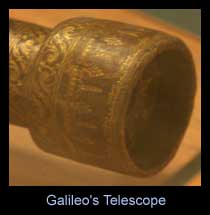
This past August my wife and I made that pilgrimage to Italy. And, from August 8 through the 18th, we retraced Galileo’s life and accomplishments from his birthplace in Pisa to the house in Arcetri that he was confined to as a part of his sentence from the inquisition. It was a life-changing experience for me. It allowed my wife and I to study a great scientist of the past and visit the places where he worked and lectured and to experience some of the same sights and smells as he did some four hundred years ago. We touched the same door he did in his house in Padua where he boarded numerous students while he constructed his own telescopes that he used to discover the moons of Jupiter. We retraced the steps he took as he made his way to Marina Gamba’s house where she and their three children lived. We walked up the same set of stairs he did at the University of Padua to give his 3 PM lectures. These experiences helped us to come to know Galileo as not just a progressive 17th century scientist, but as a person as well. It was an experience that I hope to share with my children and with my astronomy students for many years to come. It was a journey and adventure that I would recommend to anyone with an interest in how telescopic astronomy gained a foothold in the astronomical community and how Galileo helped to change the way we look at our universe.
As we find ourselves on the brink of the 400th anniversary of the invention and use of the telescope for astronomical observations and as the United Nations has declared 2009 as the International Year of Astronomy, I encourage readers to refer to my sources for this article to gain an even greater understanding of the important role that Galileo played in legitimizing telescopic, observational astronomy.
Italy, the Birthplace of Galileo and Telescopic Observational Astronomy (Padua, Venice, and Arcetri)
A brief outline of the astronomy that was done in Italy and, more specifically in Padua, Venice, and later in Arcetri is now presented beginning in Padua where Galileo spent the years from 1592 to 1610. It was here where Galileo taught mathematics, physics and astronomy. It was also in Padua that Galileo built his first telescopes and made his first observations through them. In the fall of 1609 he first targeted the Moon and stars of the Milky Way, and then he sketched them in his journal. (Instituto e Museo 2008) These sketches are the first journal entries of observations made with the use of optical aid. It was amazing to see Galileo’s journals right there in front of you.
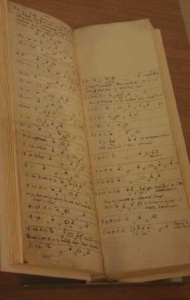 In August of 1609, while in Venice on one of his frequent trips there, Galileo heard a rumor that an instrument had been constructed in the Netherlands that made objects appear closer than they were. This confirmed what he had already heard back in June of that same year. That was all it took for Galileo to mobilize his ingenuity and mechanical aptitude to build an instrument of his own. Before the end of August, Galileo had built his own, improved telescope and presented and demonstrated it to members of the Senate in Venice. This was a very shrewd move on Galileo’s part. As a result of this quick action, he immediately won a huge victory and gained a professorship for life at the University of Padua. (Whitrow 1964) These events in 1609 set in motion the future course of Galileo’s life and it wasn’t all good.
In August of 1609, while in Venice on one of his frequent trips there, Galileo heard a rumor that an instrument had been constructed in the Netherlands that made objects appear closer than they were. This confirmed what he had already heard back in June of that same year. That was all it took for Galileo to mobilize his ingenuity and mechanical aptitude to build an instrument of his own. Before the end of August, Galileo had built his own, improved telescope and presented and demonstrated it to members of the Senate in Venice. This was a very shrewd move on Galileo’s part. As a result of this quick action, he immediately won a huge victory and gained a professorship for life at the University of Padua. (Whitrow 1964) These events in 1609 set in motion the future course of Galileo’s life and it wasn’t all good.
On the night of January 7, 1610, Galileo made the breakthrough that would in itself eventually change the concept of how the universe worked forever. These observations over a six night period, from January 7 through January 13, provided a view to Galileo that revealed that perhaps not everything orbited the Earth (geocentric model), as Ptolemy as well as the Catholic Church had adopted. And, if these small, but bright points of light went around Jupiter and not the Earth, perhaps there were other objects that did not orbit the Earth.
Galileo must have felt a twinge of fear when it first dawned on him that the geocentric model, accepted for more than 1,350 years was not correct, and that his observations would eventually create a conflict with established dogma. Yet, this did not stop him from making his observations or from publishing those observations. In fact, Galileo knew that time was of the essence — he had to publish and publish quickly or risk being scooped. So, he did publish his results, rather hastily in Mach of 1610. (Instituto e Museo 2008) It was in late March when Galileo announced to the world that he had made telescopic observations and discovered new worlds across the solar system. Siderius Nuncius, a small, innocent-looking book was a revelation of Galileo’s observations of the daily dance of the small “stars†that seemed to circle Jupiter. And after that, nothing would ever be the same. This short period of time from the summer of 1609 through to March of 1610, when Siderius Nuncius was published, had a revolutionary impact on astronomy almost overnight and it catapulted Galileo in to the scientific spotlight and into the fire and wrath of the Catholic Church.
The Importance of Padua and Venice to the History of Astronomy
I believe that one could argue that these locations in Italy are important in the history of astronomy simply because Galileo was there. But, in fact, Galileo did reside or visit these cities and what he did while he was there was of extraordinary importance in the history of astronomy.
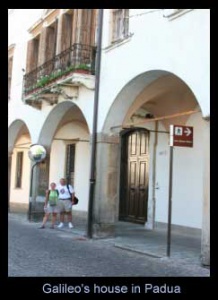
Galileo spent the happiest years of his life in Padua. (Sobel 1999) At the University of Padua, near the center of the city, Galileo taught physics, mathematics, astronomy, and military engineering. It was also in Padua, during this time, that Galileo began a relationship with a younger woman that resulted in him having three children over a ten year period of time. Although Galileo never married his mistress, he saw her often and financially supported her while living only a short walk away from her. And, when he moved to Florence in 1610 he took his children with him and left on good terms with her and the man she eventually married.
Padua is also the place where Galileo tutored students in his house. It was during this same time period, near the end of his stay there, when he constructed his own, improved telescopes, as I mentioned earlier. He also made the very first astronomical observations from his backyard in Padua. These early observations ushered in, an altogether new concept of our universe. All of this was done on a quiet street, in a small city in northern Italy.
Venice was the seat of government at that time in Northern Italy. And, Galileo enjoyed visiting there as he did often. (Sobel 1999) During the summer of 1609 Galileo was working on ways to improve his visibility as well as increase his salary. (Whitrow 1964) Now, he had three children to look after as well as to provide support to Marina, who had custody of his children. Money was tight. In August he received word from a friend in Venice that an instrument had indeed been invented and built that made distant objects appear much closer. Galileo quickly realized that this was the opportunity he had been looking for to improve his status. He set about building his own telescope that was superior to the Dutch model and with these efforts, he set in motion his next two promotions and rise to fame in the scientific and academic communities.
It was in Venice in August of 1609, where Galileo demonstrated to members of the Senate, from the tallest tower in St. Mark’s Square, that using a telescope could bring approaching ships into clear view a full two hours before the sharpest lookouts could — obviously a tremendous military advantage. The promotions, honors, and recognition that this demonstration provided to Galileo gave him the freedom he needed to pursue more vigorously, his theoretical physics, his astronomy, and his writing.
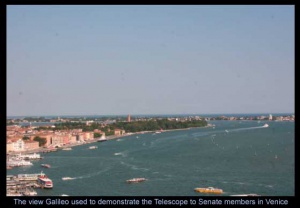
The view Galileo used to demonstrate the Telescope to Senate members in Venice
My Experience
During our stay in Italy, retracing Galileo’s steps across the country, we visited Milan, Verona, Padua, Venice, Florence, Tuscany, Lucca, Pisa, and the Cin Que Terre region along the west coast of Italy. In August, the weather is warm, even in northern Italy. During our stay however, the weather was perfect — sunny, warm and dry — every day. And, each night when we took a walk, Jupiter was lighting up the southern sky — how appropriate, I thought.
Of all the scenic and cultural beauty we saw, the places that meant the most to us were the places where we knew Galileo had been. For example, the Great Hall at the University of Padua was a stunning experience. To think that Galileo stood there in the same large room and lectured was an astonishing thought. The exquisite artwork on the ceiling and walls of the Great Hall could have occupied us for hours alone. As large as this auditorium was, roughly 25 X 25 m, Galileo was still “encouraged” to move his crowded lectures outside where there was more room to accommodate the sometimes rowdy crowds. Then, in a smaller room adjacent to the Great Hall was the lectern that Galileo taught from! Unbelievable! Seeing this was another one of those life-changing experiences.
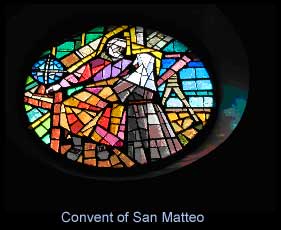 While in Florence, we made our way to the science museum, the Instituto e Museo di Storia della Scienza, where they just happened to be displaying Galileo’s instruments in a special exhibition before they were to leave Italy for a world tour celebrating 2009, as the International Year of Astronomy (IYA). This was a remarkable stroke of luck. Here, right in Florence was the majority of Galileo’s telescopes and other instruments that he made. His journals were also on display. It is no exaggeration on my part that I could have stayed there all night long. There were scarcely any people in the museum, which made it even more enjoyable.
While in Florence, we made our way to the science museum, the Instituto e Museo di Storia della Scienza, where they just happened to be displaying Galileo’s instruments in a special exhibition before they were to leave Italy for a world tour celebrating 2009, as the International Year of Astronomy (IYA). This was a remarkable stroke of luck. Here, right in Florence was the majority of Galileo’s telescopes and other instruments that he made. His journals were also on display. It is no exaggeration on my part that I could have stayed there all night long. There were scarcely any people in the museum, which made it even more enjoyable.
After reading Galileo’s Daughter and Letters to Father, both authored by Dava Sobel, I just had to experience this place — the last place Galileo lived before he died in 1642, not far from the Convent of San Matteo. And, while most of the convent and church have been modernized, there are still some pieces of original frescoes hanging from a wall that give a real sense of what things were like there in the 1620s. In the back of the modern church, there is a round stained glass window showing a likeness of Galileo, with telescope nearby, looking down at his daughter. It was here in 1613 where Galileo brought both of his daughters to live. Perhaps he sensed that his support of the Copernican universe (sun-centered), would someday remove him from their lives and so, he placed them here, with great difficulty.
It was from the convent, while Galileo lived close by that his eldest daughter Suor Maria Celeste maintained a frequent dialogue with him from 1623 through 1633 through a series of 124 letters. (Sobel 2001) These letters give us a vivid picture of what life was like in 17th century Italy. It also gave us a first hand look at the personal likes and dislikes of Galileo: what he wore, what he liked to eat, and how much he gave to others. If you do plan to visit this very historic site, I suggest that you first read Galileo’s Daughter — it will hold much more significance for you if you do.
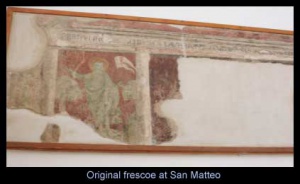
Throughout history Italy has played a key role in the development of astronomy. More recently, since the 17th century its role in ushering in the new era of telescopic astronomy has also been important. Galileo Galilei was the central figure who brought the telescope, or “perspicillum,” as he called it, into common and accepted use as an instrument for studying the heavens. (Whitrow 1964) Galileo also played a pivotal role in bringing the telescope and the discoveries made with it to the attention of the public. A visit to northern Italy is an excellent way to experience Italy and Galileo’s contributions to the progress of astronomy as one of the best subjects to use to interest and excite people of all ages and walks of life, in the universe around them.
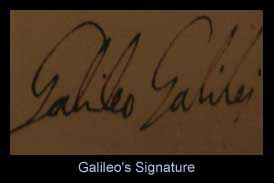
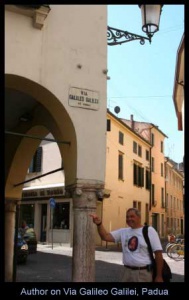 References
References
Sobel, Dava 1999, Galileo’s Universe, The New York Times, Nov. 21, 1999
The New York Times
Sobel, Dava 1996, Galileo’s Daughter, Walker Publishing Co., Inc., New York
Sobel, Dava 2001, Letters To Father, Penguin Putnam, Inc., New York
Whitrow, G.J. 1964, Galileo’s Significance in the History of Astronomy, Quarterly Journal of the Royal Astronomical Society, Vol. 5, p.182
Instituto e Museo di Storia della Scienza 2008, Galileo’s Telescope, edited by Giorgio Strano, Florence
Museo Di Storia Della Scienza 14-Aug, 2008, Florence, display of Galileo’s instruments
University of Padua 14, August, 2008 guided tour of Il Bo, 3:15 PM
